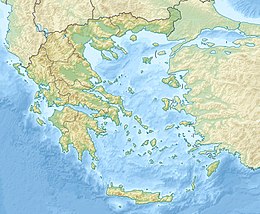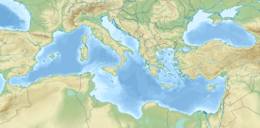
Crete is the largest and most populous of the Greek islands, the 88th largest island in the world and the fifth largest island in the Mediterranean Sea, after Sicily, Sardinia, Cyprus, and Corsica. Crete rests about 160 km (99 mi) south of the Greek mainland, and about 100 km (62 mi) southwest of Anatolia. Crete has an area of 8,450 km2 (3,260 sq mi) and a coastline of 1,046 km (650 mi). It bounds the southern border of the Aegean Sea, with the Sea of Crete to the north and the Libyan Sea to the south. Crete covers 260 km from west to east but is narrow from north to south, spanning three longitudes but only half a latitude.

The Aegean dispute is a set of interrelated controversies between Greece and Turkey over sovereignty and related rights in the region of the Aegean Sea. This set of conflicts has strongly affected Greek-Turkish relations since the 1970s, and has twice led to crises coming close to the outbreak of military hostilities, in 1987 and in early 1996. The issues in the Aegean fall into several categories:
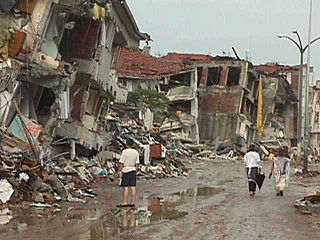
Greek–Turkish earthquake diplomacy is a phenomenon that has existed with notability since the summer of 1999, when Greece and Turkey were hit by successive earthquakes. It began with a generous Greek relief effort in Turkey following the İzmit earthquake on 17 August. Less than a month later, on 7 September, the Athens earthquake occurred and was met with a similarly generous Turkish relief effort in Greece. Prior to these mutual efforts, Greece–Turkey relations were generally marked by near-constant hostility stemming from the Istanbul pogrom of 1955. The magnanimous development of "earthquake diplomacy" between the two countries generated an outpouring of sympathy and assistance provided by ordinary Greeks and Turks in both cases; such acts were encouraged from the top and took many foreigners by surprise. They prepared the public for a breakthrough in bilateral ties, which had been marred by decades of diplomatic tension and, in the case of Cyprus, armed conflict.
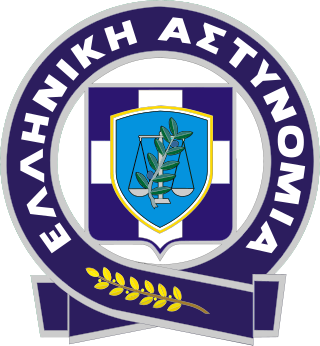
The Hellenic Police is the national police service and one of the three security forces of Greece. It is a large agency with responsibilities ranging from road traffic control to counter-terrorism. Police Lieutenant General Dimitrios Mallios currently serves as Chief of the Hellenic Police. He replaced Lazaros Mavropoulos. The Hellenic Police force was established in 1984 under Law 1481/1-10-1984 as the result of the fusion of the Gendarmerie and the Cities Police forces.

Legislative elections were held in Greece on Sunday, 20 September 2015, following Prime Minister Alexis Tsipras' announced resignation on 20 August. At stake were all 300 seats in the Hellenic Parliament. This was a snap election, the sixth since 2007, since new elections were not due until February 2019.
The 1956 Amorgos earthquake occurred at 03:11 UTC on July 9. It had a magnitude of 7.7 on the moment magnitude scale and a maximum perceived intensity of IX on the Mercalli intensity scale. The epicentre was to the south of the island of Amorgos, the easternmost island of the Cyclades in the Aegean Sea. There was significant damage on Amorgos and the neighbouring island of Santorini. It was the largest earthquake in Greece in the 20th century. It was followed 13 minutes later by a magnitude 7.2 earthquake near Santorini. It triggered a major tsunami with a maximum run-up of 30 m. The combined effects of the earthquake shaking and the tsunami caused the deaths of 53 people with a further 100 injured.
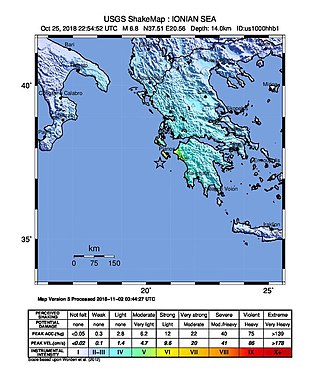
A strong earthquake measuring magnitude Mw 6.8 occurred in the Ionian Sea near the coasts of Greece during the night between 25 and 26 October 2018 at 22:54:51 UTC. Sea level changes were predicted, and a tsunami advisory was issued. Reports of sea level change of up to 20 centimeters were reported in Greece and Italy.
In the run-up to the May 2023 Greek legislative election, various organizations carry out opinion polling to gauge voting intention in Greece during the term of the 18th Hellenic Parliament. Results of such polls are displayed in this article. The date range for these opinion polls is from the previous legislative election, held on 7 July 2019, to the day the next election was held, on 21 May 2023.
The 2024 European Parliament election in Greece will be held on 9 June 2024 as part of the 2024 European Parliament election. This will be the first to take place after Brexit.

Assembly of Greeks is a far-right, ultranationalist Greek political party. It was founded by Artemis Sorras.

An earthquake with a moment magnitude of 7.0 occurred on 30 October 2020 about 14 km (8.7 mi) northeast of the Greek island of Samos. Although Samos was closest to the epicentre, it was the Turkish city İzmir, 70 km (43 mi) northeast that was heavily affected—more than 700 residential and commercial structures were seriously damaged or destroyed. One hundred and seventeen people died in İzmir Province while an additional 1,034 were injured. In Greece, there were two fatalities and 19 injured. The earthquake is the deadliest in the year 2020, and the third major earthquake to strike Turkey that year. The event is called the Samos earthquake by the International Seismological Centre.
The 1856 Heraklion earthquake, also known as the Crete earthquake or Rhodes earthquake, occurred on the morning of October 12 at 02:45 am local time. This extremely catastrophic earthquake had an estimated magnitude of 7.7 to 8.3 at a depth of approximately 61 to 100 km. The earthquake was felt over a very wide area extending from Sicily, Italy to the Levant and North Africa. On the Greek island of Crete, the effects of the earthquake were cataclysmic, over 500 bodies were recovered in the city of Heraklion. Shockwaves from the earthquake were felt intensely, covering all of the Ottoman Empire; present-day Turkey, Cyprus and the Middle East where damage and human losses were reported. In Malta, the earthquake collapsed the Għajn Ħadid Tower—a coastal watchtower built around the year 1638. In Cairo, Egypt, the earthquake destroyed buildings, created seiches in canals, and killed several people. Off the Egyptian and Italian coasts, sailors reported feeling a seaquake.
The 1986 Kalamata earthquake struck the southern Peloponnese Region of Greece on September 13 at 20:24 local time. The 12.5 km (7.8 mi) deep moment magnitude (Mw ) 5.9 earthquake had an epicenter near the coastal city of Kalamata and was assigned X (Extreme) on the Mercalli intensity scale. The earthquake was the result of normal faulting along a northwest-dipping fault and produced surface ruptures. Extensive damage was reported in Kalamata and Elaiochori. At least 20 people died and 330 were injured. Survivors sought refuge at campsites and reconstruction work lasted five years.

On March 3, 2021, 12:16:09 the 2021 Larissa earthquake had a magnitude of 6.3 with an intensity of VIII (Severe) on the Mercalli Scale 9 kilometers west of Týrnavos, Greece. One person was confirmed dead with eleven other people injured. Light shaking was also felt as far as Albania, North Macedonia, Kosovo and Montenegro.
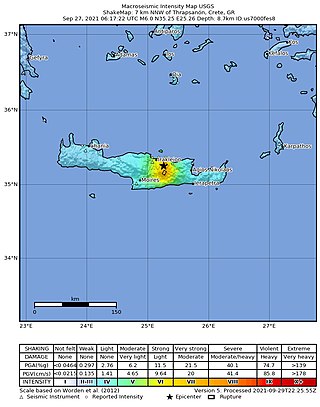
A moment magnitude 6.0 earthquake struck the island of Crete in Greece at a depth of 6 km on 27 September 2021. The epicenter of the earthquake was located southeast of Heraklion. The quake killed one person, injured 36 and damaged over 5,000 old buildings on the island.

Storm Ballos was a notable extratropical cyclone that caused devastating floods across Greece during mid-October 2021. The second storm to be officially named in conjunction with the naming list of the former, Israel and Cyprus, Ballos formed on 13 October over the Mediterranean Sea from the combination of a frontal system and a circulation which first developed, two days earlier. It then moved over Greece, before proceeding into the Aegean Sea, where it slowly weakened and dissipated by 16 October. However, despite the HNMC naming the system, the Free University of Berlin (FUB) didn’t assign any name on it along with its weather maps.
Anastasios Nyfadopoulos is a Greek interdisciplinary artist whose work is particularly known for exploring the themes of interconnectivity and perpetual change. He has exhibited his work in numerous exhibitions in Greece and abroad. One of his most notable works, the sculpture "Crisis", became known as the first public sculpture referring to the reverberations of the socio-economic crisis on humanity.
In the run-up to the next Greek legislative election, various organizations carry out opinion polling to gauge voting intention in Greece. Results of such polls are displayed in this article. The date range for these opinion polls is from the previous legislative election, held on 25 June 2023, to the present day.
